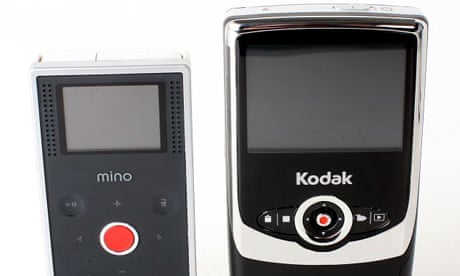It's the war of the diddy video cameras! Except that Kodak's £130 Zi6, the newer of the two - the other being the £120 Flip Mino (the new, smaller sibling of the Flip Ultra) - can do a lot more: as well as being able to record in two different high-definition resolutions, it can also take stills. One up to the Zi6.
The Flip Mino, however, scores heavily on usability. It's slightly smaller and lighter than the Zi6, and sits easily in the hand. It's got just three buttons: power, the USB plug release (which comes out of the top), and the big, obvious red button that starts and stops recording. Once it's on, small lights come on under the back sheet for zoom in and out, back and forward, delete, and play/pause. There's a tiny speaker for playback, a red light (on the lens side) when you're recording, and a TV-out jack. The onscreen display tells you how much recording time you have left; the rechargeable batteries are sealed inside. On the bottom is a tripod socket. That's really it. As you film, you see how much time is left. Recordings are VGA (640x480) quality, in AVI format (which can be an obstacle to Mac users: the free VLC from videolan.org will play them, or there's player software included in the Mino). Now, go and make a 60-minute film.
By contrast, the Zi6 adds quite a lot more functionality. It too has the minimum of buttons - one for power, another to pop its USB plug, and the red-tipped joystick for recording, zooming in/out, and setting the recording method: HD (that is, 1280x720 pixels), "HD60" (at 60 frames per second) or boring VGA stills (640x480). There's also a macro/distance lens, and two outputs: TV-out (the standard composite) and "HD". You want it all? The Zi6 has most of it. But it can be confusing if you're on the wrong lens, or taking stills, when you just want to point-and-shoot. And it can't say how much recording time is left, because you might use different resolutions. One up to the Mino.
The Zi6 saves in Apple's Quicktime .mov format, which might pose a problem for Windows users; but there's viewing software included.
A key difference: you have to enhance the Zi6's paltry onboard storage with an SD card, upping the overall cost. The rechargeable batteries are removable (a charger is provided), which is good: when they die, you can replace them. When the Mino's dead, what will you do? Throw it away and buy a new one, probably. Final score? Even.
Pros: Zi6: HD; stills; flexibility; Mino: simple, accessible, small
Cons: Zi6: needs extra storage; Mino: limited functions, low-res
